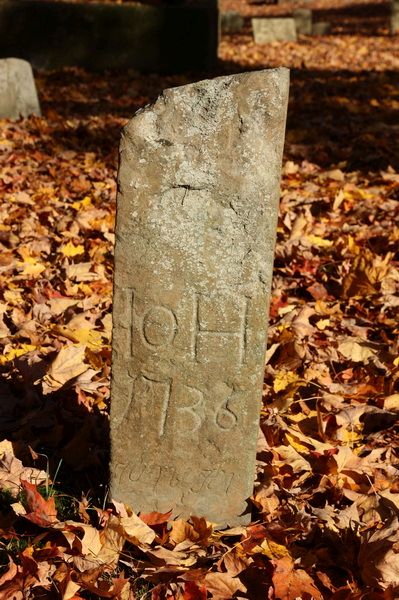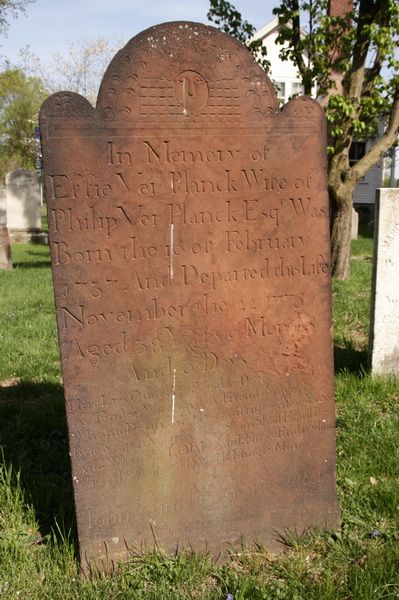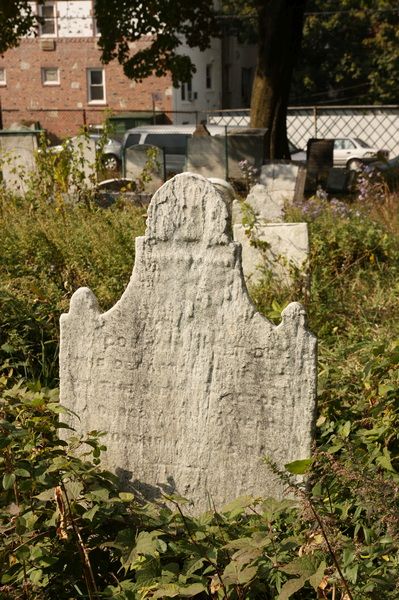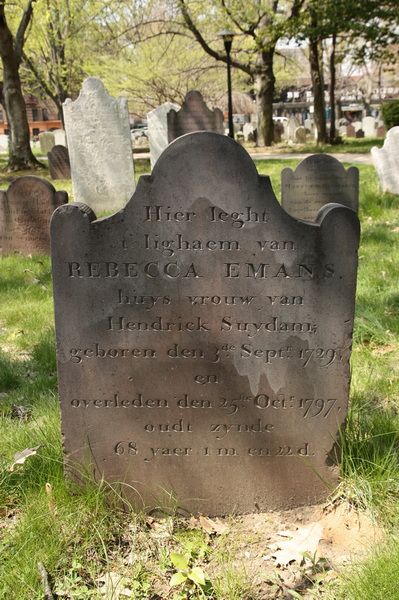Early Dutch Cemeteries III - Materials and texts
The natural stone and stone carving traditions used
In the cemeteries described so far, the oldest headstones are all hewn from a brown sandstone that comes mainly from local quarries in Newark, New Jersey. This is in contrast to the use of slate in New England. Few slate funerary monuments are found in the Hudson Valley. The oldest sandstone examples here date from the early eighteenth century.
The sandstone stones follow the later example of a narrow stele with a shouldered, rounded top. But there are still a number of places where examples can be found that can be regarded as the precursors of the sandstone steles. In Tapan, Kingston and Rhinebeck headstones can be found that appear to be made of fieldstone of schist found on site [1]. They are often rough, rectangular pieces of stone, but clearly not professionally worked. It is possible that families worked them themselves because no stonemasons were available. The rough appearance and the clumsy texts clearly distinguish them from the later eighteenth-century sandstone tombstones. The texts referred to are often no more than a few initials with a year. It is clear to see that the text of a number is in Dutch. This distinguishes them from the so-called footstones that families placed at their graves in the following centuries to mark the places. These footstones are only a foot or two in height and contain only the family initials. They can still be found everywhere, but mainly date from the later eighteenth century. They are often well finished in contrast to the rough-worked stones that are among the oldest funerary monuments in the Hudson Valley.
 USA-030. Simple stele of local fieldstone in Rhinebeck cemetery. (Photo Leon Bok, 2009)
USA-030. Simple stele of local fieldstone in Rhinebeck cemetery. (Photo Leon Bok, 2009)
The reason why sculpture in the Hudson Valley did not take off until the mid-18th century certainly has to do with the fact that the WIC banned guilds in New Netherland. Craftsmanship and traditions were mainly passed on in the Netherlands through guilds, but the guilds also had a lot of power. The WIC did not want that in their colony. At the same time, this meant that there was hardly any stonemason's tradition in the colony. Moreover, certainly in the seventeenth century there was still insufficient work for a stonemason in the field of funerary monuments. It is therefore not surprising that the first stonemasons who became known for their burial work came from the English colonies. Although they were used to carving monuments in slate, they adopted the easy-to-work sandstone in the New York area. From their English background, the stonemasons also took with them the tradition of funerary symbols that are so recognizable on the eighteenth-century funerary monuments. Winged skulls and angels are common. Beginning in 1720, stonemasons from New Jersey carved grave work that was also scattered in the Hudson Valley. Around 1750 a tombstone tradition arose in New York, which subsequently went through a complete development. This development is different from that in New England and occupies its own place in the history of burial culture in America.
 USA-027. Work by John Zuricher in the cemetery of Fishkill, in this case with an English text. At the bottom of the stele Zuricher has chiseled his name. (Photo Leon Bok, 2009)After more craftsmen became available, the tombstones were more often elaborated with more text, more designed and beautiful images of especially winged angel heads. In the Hudson Valley, John Zuricher in particular was a well-known and popular stonemason. Zuricher came from the Dutch community and was a member of the Dutch Church in New York. His clientele was therefore predominantly of Dutch descent. He had a shop in New York and delivered rocks all over the Hudson Valley. He did this from the forties of the eighteenth century until the American revolution. Not long after, in 1775, he left for Haverstraw Precinct, north of New York. There he worked on stones until 1778. Zuricher died in 1784; the location of his grave is unknown. His work is spread over a vast area around New York City, as evidenced by the many examples that can still be found.
USA-027. Work by John Zuricher in the cemetery of Fishkill, in this case with an English text. At the bottom of the stele Zuricher has chiseled his name. (Photo Leon Bok, 2009)After more craftsmen became available, the tombstones were more often elaborated with more text, more designed and beautiful images of especially winged angel heads. In the Hudson Valley, John Zuricher in particular was a well-known and popular stonemason. Zuricher came from the Dutch community and was a member of the Dutch Church in New York. His clientele was therefore predominantly of Dutch descent. He had a shop in New York and delivered rocks all over the Hudson Valley. He did this from the forties of the eighteenth century until the American revolution. Not long after, in 1775, he left for Haverstraw Precinct, north of New York. There he worked on stones until 1778. Zuricher died in 1784; the location of his grave is unknown. His work is spread over a vast area around New York City, as evidenced by the many examples that can still be found.
At the same time, other stonemasons also stepped forward. Often they came from England or the Boston area, New England. Like Zuricher, the American freedom struggle meant a hiccup in their production. Many stonemasons were cut off from their customers by the war. They picked up again after the British had disappeared. Many stones with dates between 1776 and 1783 will have been made after that time.
 USA-007. Marble stele from the nineteenth century in the cemetery of New Utrecht, Brooklyn. Text and image have virtually disappeared. (Photo Leon Bok, 2009)Until this period mainly brown sandstone was used. Not long after, the sandstone was supplanted by the type of stone that is more familiar to us: marble. The shape also changed. More and more tall narrow stelae with straight tops appeared, sometimes with willows and other nineteenth-century funerary motifs. The change in material is most striking: instead of brown-red sandstone, a white limestone is used, which is generally called 'marble'. This material apparently appealed more than the brown, somewhat dark surface of the previously used sandstone. Unfortunately for us, the marble is heavily weathered. Many texts on nineteenth-century stones are no longer legible, unlike many of the sandstone stelae. Not that those stones didn't suffer from exposure to wind and weather, but they react differently than the marble. The sandstone has the characteristic to split, sometimes causing entire parts to be lost. This does not always have to affect the text, but a lot can be lost in the event of serious damage. The surface of the marble stones, on the other hand, slowly wears away until there is no text left.
USA-007. Marble stele from the nineteenth century in the cemetery of New Utrecht, Brooklyn. Text and image have virtually disappeared. (Photo Leon Bok, 2009)Until this period mainly brown sandstone was used. Not long after, the sandstone was supplanted by the type of stone that is more familiar to us: marble. The shape also changed. More and more tall narrow stelae with straight tops appeared, sometimes with willows and other nineteenth-century funerary motifs. The change in material is most striking: instead of brown-red sandstone, a white limestone is used, which is generally called 'marble'. This material apparently appealed more than the brown, somewhat dark surface of the previously used sandstone. Unfortunately for us, the marble is heavily weathered. Many texts on nineteenth-century stones are no longer legible, unlike many of the sandstone stelae. Not that those stones didn't suffer from exposure to wind and weather, but they react differently than the marble. The sandstone has the characteristic to split, sometimes causing entire parts to be lost. This does not always have to affect the text, but a lot can be lost in the event of serious damage. The surface of the marble stones, on the other hand, slowly wears away until there is no text left.
The use of sandstone and marble was overtaken by granite or other more durable stone in the late 1800s. Zinc was also used, but not as much as cast iron. Wood was hardly used, but that no surprise with the large amounts of stone in the vicinity.
Dutch texts
As indicated earlier, there are still quite a few grave monuments with Dutch texts. The oldest stones have an operation that seems to have been made by individuals and not by skilled people. Simple words like 'Anno' or 'Familie' indicate the Dutch origin of the deceased. Although many funerary monuments were later made by stonemasons with a Dutch background, the texts are sometimes very misspelled. On some stones the stonemason seems to have had little knowledge of what he wrote and many mistakes have been made. What is very nice are the somewhat more elaborate poetic texts on some stones. Such texts provide a vivid image of the world in which people lived at that time. The texts are certainly also special because eighteenth-century funerary monuments with such texts are a rarity in the Netherlands itself.
 USA-017. Stele for Rebecca Emans, died in 1797, in the cemetery of Flatbush. The text is still entirely in Dutch, but the word 'leght' at the top differs from the common 'leyt'. (Photo Leon Bok, 2009)
USA-017. Stele for Rebecca Emans, died in 1797, in the cemetery of Flatbush. The text is still entirely in Dutch, but the word 'leght' at the top differs from the common 'leyt'. (Photo Leon Bok, 2009)
Conclusion
Unlike the English funerary monuments in New England, burial culture in the Hudson Valley has been little explored. It is hard to get a good picture of the burial culture from the beginning of the first colony due to the strong urban growth of this area. As early as the seventeenth century, cemeteries had to make way for roads and buildings. The remains of some cemeteries have been transferred to new cemeteries, but often the stones were used for other purposes. Much is also still unknown about the custom of the Dutch to bury in churches. For a long time it was believed that the Dutch had no tradition in this area and that they did not mark their graves. When they did, they would simply have adopted the English traditions. Recent research has shown that this is certainly not the case.
Thanks to Marieke Leeverink.
Early Dutch Cemeteries I - New Amsterdam • Early Dutch Cemeteries II - Outside New Amsterdam • Early Dutch Cemeteries III - Materials and texts
Note
- Schist is a metamorphic rock that splits easily and is not very difficult to work with. Schist forms a large part of the subsurface in New York State.
Literature
- Haacker, Fred C.; Burials in The Dyckman-Nagel Burial Ground, 1954.
- Inskeep, Carolee, The graveyard shift: a family historian's guide to New York City cemeteries, Orem Utah 2000.
- Richards, Brandon Karl; Comparing and Interpreting the Early Dutch and Englisch Gravemarkers of New York’s Lower Hudson Region; 2005.
- Sypher, F.J. (vertaling en bewerking); Liber A. 1628-1700 of the collegiate churches of New York, Grand Rapids (MI) 2009
- Welch, Richard F.; The New York and New Jersey Gravestone Carving Tradition, in Markers IV, 1987 (uitgave van de Association for Gravestone Studies)
- Wieder, F.C. (inleiding en bezorging); De stichting van New York, Zutphen 2009.
Part of this article was delivered in a lecture at Columbia University in New York on October 29, 2009. The research for that lecture and this article was made possible in part by the Netherlands America Foundation (NFA) and supported by Professor Norman Weiss of the Columbia University.
- Last updated on .


